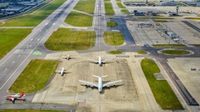Gatwick Airport, one of the UK’s busiest air travel hubs, is set for a major transformation after Transport Secretary Heidi Alexander gave the green light to a £2.2 billion second runway scheme on September 22, 2025. The decision, which comes after years of debate, planning, and public scrutiny, marks a pivotal moment for both the aviation industry and the communities surrounding the West Sussex airport. Supporters tout the project as a much-needed boost for the economy, while environmental campaigners warn it could spell disaster for the UK’s climate commitments.
The newly approved project involves shifting Gatwick’s emergency runway 12 metres north, converting it into a full-time operational runway capable of handling narrow-bodied aircraft such as the Airbus A320 and Boeing 737. This bold move is expected to raise the airport’s capacity by an additional 100,000 flights each year. According to The Guardian, the first flights from the new runway could take off as early as 2029, ushering in a new era for a facility already recognized as the world’s busiest single-runway airport.
Gatwick Airport Limited, the company overseeing the project, first submitted its application to the Planning Inspectorate on July 6, 2023. The application was accepted for examination a month later, on August 3, 2023. After months of detailed review and public input, recommendations were delivered to the Secretary of State on November 27, 2024. The process was described by Stewart Wingate, managing director of Vinci Airports—Gatwick’s majority shareholder—as “lengthy and rigorous.” In his words, “After a lengthy and rigorous planning process, we welcome the government’s approval of plans to bring our Northern Runway into routine use, ahead of the expected deadline. This is another important gateway in the planning process for this £2.2bn investment, which is fully funded by our shareholders and will unlock significant growth, tourism and trade benefits for London Gatwick and the UK, and create thousands of jobs.”
The economic stakes are high. Officials forecast the expansion will generate up to £1 billion in extra economic activity annually and create 14,000 jobs. Karen Dee, chief executive of Airports UK, emphasized the broader impact, stating, “UK airports already contribute £1bn a week in gross value added, support nearly one million jobs, and facilitate almost £100bn in trade through air freight. Expanding capacity at our airports, which will take place in accordance with the sector’s commitment to sustainability and decarbonization by 2050, will support economic growth.”
The development is privately financed, with no direct taxpayer funding required. The project also includes amendments to taxiways, terminal extensions, upgrades to ancillary facilities, and improvements to highways and local rivers. Temporary construction works and mitigation measures are planned to minimize disruption during the build.
Yet, the path to approval was anything but smooth. The Planning Inspectorate initially rejected the scheme, citing concerns over noise and environmental impact. However, the project eventually won support after adjustments were made—most notably, the introduction of noise mitigation measures and targets to increase the proportion of passengers using public transport to access the airport. While these so-called “mode share” targets are not legally binding, ministers argue they will help ease local anxieties about traffic and pollution.
Residents facing increased aircraft noise will be offered compensation packages. These include funding for triple-glazing windows to reduce noise in their homes, or, for those wishing to move, financial contributions toward estate agent fees and stamp duty. According to government officials, these measures demonstrate a commitment to balancing growth with community well-being.
Still, not everyone is convinced. Environmental groups and Green Party leader Zack Polanski have slammed the expansion as a betrayal of the UK’s climate pledges. Polanski did not mince words, declaring, “Signing off on a second runway at Gatwick is a disaster. It ignores basic climate science and risks undermining efforts to tackle the climate crisis. Labour keeps wheeling out the same nonsense about growth, but at what cost? What this really means is more pollution, more noise for local communities, and no real economic benefit.”
The statistics behind these concerns are sobering. In 2022, UK flights produced 29.6 million tonnes of CO2 equivalent emissions, accounting for about 7% of the nation’s total greenhouse gas output. Critics argue that while other sectors—like road transport—can be decarbonized through electrification, aviation remains one of the hardest industries to clean up. “Expanding Gatwick is a tired, 20th-century answer to a 21st-century crisis. Labour’s obsession with growth at all costs is driving us deeper into a climate breakdown and social inequality crisis,” Polanski added.
Heidi Alexander, for her part, has been clear about her stance. At a dinner with air-travel executives earlier in the year, she remarked that she “believes in airport expansion” and is “not some kind of flight-shaming eco-warrior.” According to BBC reporting, she has consistently argued that the expansion can proceed without breaching the UK’s carbon budget, and that the plans are robust enough to withstand legal and environmental challenges.
The government’s official line is that the expansion will allow Gatwick to support an extra 80 million passengers annually, and that the economic benefits will ripple far beyond the airport’s immediate vicinity. But environmentalists and some local residents remain skeptical. They question whether the promised economic windfall justifies the likely increase in pollution, noise, and pressure on local services.
To provide some perspective, the UK government is currently committed to £11.6 billion in International Climate Finance between 2021/2022 and 2025/2026—an average of just under £3 billion per year aimed at adaptation and mitigation strategies. Yet, as climate extremes batter Europe with record heatwaves and wildfires, the wisdom of expanding one of the hardest-to-decarbonize sectors is being hotly debated.
While the government is determined to press ahead—emphasizing both the economic benefits and the mitigation measures in place—critics warn that today’s decision could complicate future airport expansions, especially at Heathrow, given the UK’s legally binding climate targets. For now, Gatwick’s second runway stands as a symbol of the country’s ongoing struggle to balance growth, connectivity, and climate responsibility.
The coming years will reveal whether this gamble pays off, both for the economy and the environment.




